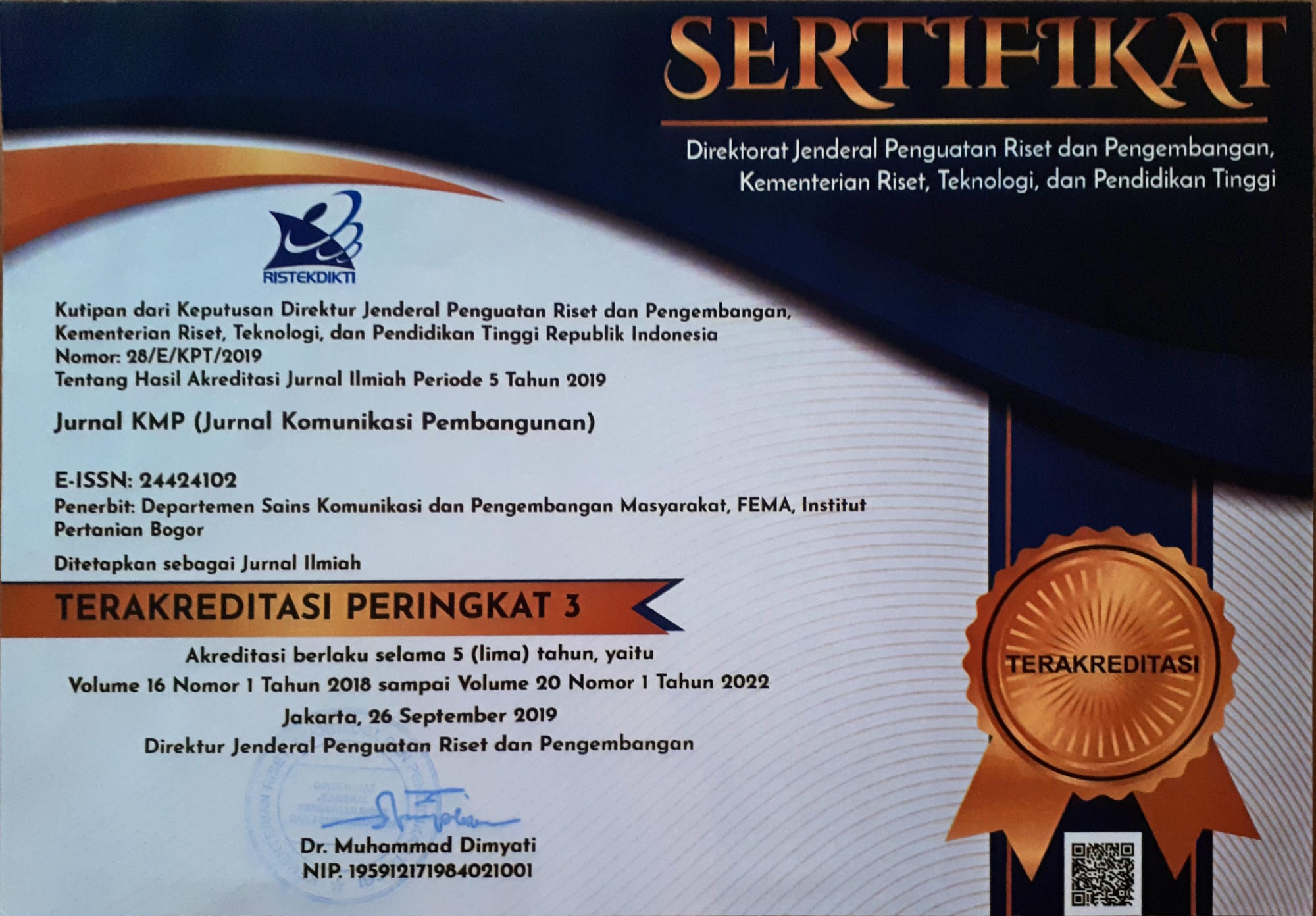Political Communication Channel Political Communication in The Development of Democracy on Legislative Election of DPR-RI in Bogor City
DOI:
https://doi.org/10.46937/18202031350Keywords:
democracy building, development communication, legislative elections, political communication channels, voting decisionsAbstract
In developing democracy, political communication is needed through various existing communication channels, especially in elections where the public needs a lot of political information needed as material in determining political decisions. This study aims to determine the effect of mass political communication channels, interpersonal communication channels and organizational communication channels on the decision to vote for parties in the DPR RI legislative elections in Bogor City in 2019. The research uses quantitative methods with a survey design with a sample of 240 voters in Bogor City. Determination of the sample using multistage random sampling techniques and data obtained using multinominal logistic regression analysis. The results showed that open campaigns, social media, blusukan, volunteers and religious leaders influenced the decision significantly to vote the party. Meanwhile, television media, billboards / posters, newspapers and face-to-face dialogues proved to have no effect in the decision to vote.
Downloads
References
Anwar, A. (2003). Komunikasi Poitik : Paradigma-Teori-Aplikasi-Strategi dan Komunikasi Politik Indonesia. Jakarta: PT Balai Pustaka.
Arianto, B. (2016). Fenomena Relawan Politik dalam Kontestasi Presidensial 2014. Jurnal Ilmu Sosial Dan Ilmu Politik, 18(2), 130. https://doi.org/10.22146/jsp.13128
Cangara H. (2009). Komunikasi Politik ;Konsep, teori dan strategi. In Communication Science.
Creswell, J. W. (2016). Research Design: Pendekatan Metode Kualitatif, Kuantitatif, dan Campuran. In SAGE Publication.
Cwalina, W., Falkowski, A., & Newman, B. I. (2015). Political marketing: Theoretical and strategic foundations. In Political Marketing: Theoretical and Strategic Foundations. https://doi.org/10.4324/9781315701684
Deželan, T., & Maksuti, A. (2012). Slovenian election posters as a medium of political communication : an informative or persuasive campaign tool? Communication, Politics & Culture, (45), 140–159.
Gama, B, Sudardi, B., Abdullah, W., & Wijaya, M. (2019). Blusukan Cultural as a Political Power in The Regional Head Election of Surakarta. 2282681. https://doi.org/10.4108/eai.21-12-2018.2282681
Gama, Betty, Sudardi, B., Abdullah, W., & Wijaya, M. (2018). Construction of Blusukan Meaning in the Campaign of Regional Heads. (1416), 1416–1427.
Gerber, A. S., Gimpel, J. G., Green, D. P., & Shaw, D. R. (2011). How large and long-lasting are the persuasive effects of televised campaign ads? Results from a randomized field experiment. American Political Science Review, 105(1), 135–150. https://doi.org/10.1017/S000305541000047X
Gordon, B. R., & Hartmann, W. R. (2013). Advertising effects in presidential elections. Marketing Science, 32(1), 19–35. https://doi.org/10.1287/mksc.1120.0745
Hosmer, D. W., & Lemeshow, S. (2000). Applied logistic regression. 2nd Edition. In John Wiley & Sons, Inc.
Kaid, L. L. (1993). Political Communication. In Communication Booknotes (Vol. 24). https://doi.org/10.1080/10948009309389650
KPU. (2015). Peraturan Pemilihan Umum Nomor 7 Tahun 2015. Retrieved from https://jdih.kpu.go.id/data/data_pkpu/PKPU Nomor 7 Tahun 2015.pdf.
KPU. (2019). KPU Jawa Barat Gelar Evaluasi Partisipasi Masyarakat Dalam Pemilu 2019. Retrieved from https://jabar.kpu.go.id/2019/09/kpu-jawa-barat-gelar-evaluasi-partisipasi-masyarakat-dalam-pemilu-2019/.
O’cass, A. (2002). Political advertising believability and information source value during elections. Journal of Advertising, 31(1), 63–74. https://doi.org/10.1080/00913367.2002.10673661
Putra, A. M. (2011). Media Baru dan Fenomena Komunikasi Politik pada Pemilukada di Provinsi Banten 2011. Jurnal ULTIMA Comm, 3(2), 23–34. https://doi.org/10.31937/ultimacomm.v3i2.203
Riaz, S. (2014). Effects of New Media Technologies on Political Communication. Journal of Political Studies, 1(2), 161–173.
Ron, S. (2009). The political participation puzzle and marketing. Journal of Marketing Research. https://doi.org/10.1509/jmkr.46.6.798
Safiullah, M., Pathak, P., Singh, S., & Anshul, A. (2017). Social media as an upcoming tool for political marketing effectiveness. Asia Pacific Management Review, 22(1), 10–15. https://doi.org/10.1016/j.apmrv.2016.10.007
Siagian, H. F. (2012). Pengaruh Kredibilitas Komunikator Politik Untukmendapatkan Dukungan Khalayak Dalam Pemilihan Umum. Jurnal Dakwah Tabligh, 13(2), 281–291.
Subakti, R. (2007). Memahami Ilmu Politik. In Journal of Chemical Information and Modeling. https://doi.org/10.1017/CBO9781107415324.004
Sumarwan, U. (2003). Perilaku Konsumen: Teori dan penerapannya dalam Pemasaran. Ghalia Indonesia, Jakarta.
Susanto, E. H. (2017). MEDIA SOSIAL SEBAGAI PENDUKUNG JARINGAN KOMUNIKASI POLITIK. Jurnal ASPIKOM. https://doi.org/10.24329/aspikom.v3i3.123
Venus, A. (2004). Manajemen Kampanye; Panduan Teoritis Dan Praktis. Dalam Mengefektifkan Kampanye Komunikasi. Bandung: Simbiosa.
Zulkarnain, A., & Harris, S. (2017). Fenomena Blusukan Dalam Model Kepemimpinan Politik Joko Widodo. Jurnal Politik Universitas Nasional, 13(1), 1928–1942.
Downloads
Published
Issue
Section
License
Copyright Notice
Authors who publish with this journal agree to the following terms:
1. Authors contributing to Jurnal Komunikasi Pembangunan retain copyright to their articles but agree to publish them under a a Creative Commons Attribution-Non Commercial- ShareAlike (CC BY-NC-SA)
2. Authors retain the copyright to their work. Users may read, copy and distribute the work in any form, provided the authors and the journal are appropriately credited or cited.
3. Authors are permitted and encouraged to post their articles, after publication, to personal and/or institutional websites and to archive their articles in institutional or funder repositories to insure even greater public access. Supplementary material should also be included when applicable. In addition, authors are permitted to post pre-print versions of their articles to institutional websites, repositories and similar (on the condition that all bibliographic information is also provided). However, authors are not allowed to send their manuscript to other scientific journals once it has been decided to be reviewed by reviewers at Jurnal Komunikasi Pembangunan (Jurnal KMP).
Read our instruction for authors for more information.












